NavSource Online: Submarine Photo Archive

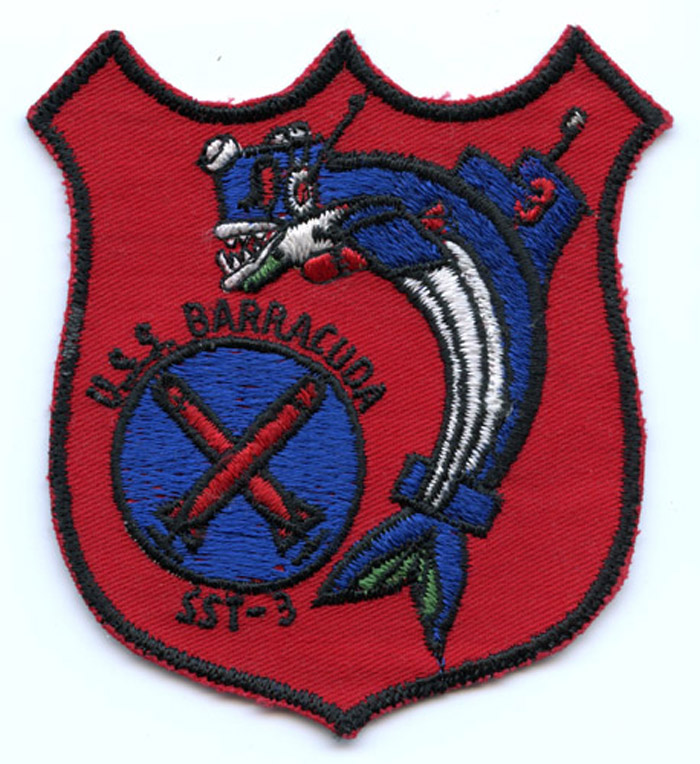
Contributed by Dan Bailey
Please report any broken links or trouble you might come across to the Webmaster.
Please take a moment to let us know so that we can correct any problems and make your visit as enjoyable and as informative as possible.


| Click On Image For Full Size | Size | Image Description | Source | |
|---|---|---|---|---|
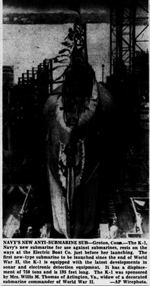 0855016 |
NR | NAVY’S NEW ANTI-SUBMARINE SUB Groton, CT., The Barracuda (SSK-1), Navy’s new submarine for use against submarines, rests on the ways at the Electric Boat Co. just before her launching. The first new-type submarine to be launched since the end of World War II, the (SSK-1) is equipped with the latest developments in sonar and electronic detection equipment. It has a displacement of 750 tons and is 195 feet long. The (SSK-1) was sponsored by Mrs. Willis M. Thomas of Arlington, Va., widow of a decorated submarine commander of World War II. |
A. P. Wirephoto. Image and text provided by Library of Congress, Washington, DC. Photo & text by Evening Star. [volume] (Washington, D.C.) 1854-1972, 03 March 1951, Image 3, courtesy of chroniclingamerica.loc.gov. | |
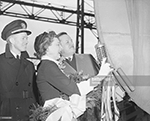 | 727k | Original Caption 3/2/1951-Groton, CT: Widow of the commander of the submarine Pompano (SS-181) in World War II, Mrs. Willis Manning Thomas, is shown as she prepared to launch the Navy's newest and deadliest submarine, called the K-1. Standing by are Lt. James E. Carter, 26 (left), of Plains, GA., one officer of the crew that'll man the craft, and J. J. Hopkins, President of the Electric Boat Company, builders of the craft, Mrs. Thomas is from Arlington, VA. | Photo by Bettmann/Getty Images, courtesy of gettyimages.com. | |
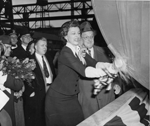 0855047 | 235k | Mrs. Willis Manning Thomas christening the Barracuda (SSK-1). | Photo courtesy of Dale Hargrave. | |
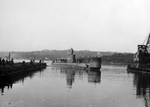 0855030 | 1.12k | Launching of Barracuda (SST-3), 15 March 1962. | Photo courtesy of history.navy.mil | |
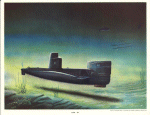 | 411k | Oil on canvas of the Barracuda (SSK-1) underway. | USN photo courtesy of csg2.navy.mil. | |
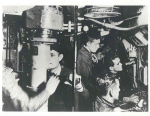 | 183k | Jimmy Carter at work on the periscope of the submarine Barracuda (SSK-1), circa 1951.
| USN photo courtesy of csg2.navy.mil. | |
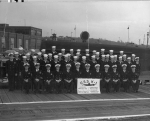 | 199k | Jimmy Carter and the crew of the submarine Barracuda (SSK-1), in 1951.
| USN photo courtesy of csg2.navy.mil. | |
 | 160k | Postal cover with an insert of the Barracuda (SSK-1), 1952. | Courtesy of Jack Treutle (of blessed memory). | |
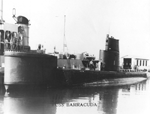 | 213k | Barracuda (SSK-1) early in her career. | Photo courtesy of Scott Koen & ussnewyork.com. | |
 | 207k | Barracuda (SSK-1) at New London, Conn. | Photo # 06_10_004349 courtesy of Boston Public Library, Tichnor Brothers collection, digitalcommonwealth.org. | |
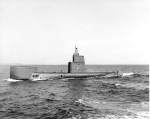 | 199k | Portside view of the Barracuda (SSK-1) underway, circa 1951-59. | USN photo courtesy of csg2.navy.mil. | |
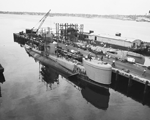 0855014 | 545k | A view of Barracuda (SSK-1) and an unidentified submarine undergoing updating at a New London pier in the 1950's. | Photo by J R Eyerman, Life Magazine via John Chiquoine. | |
 | 59k | Barracuda (SSK-1), in New Orleans during the Mardi-Gras, 1955. | Courtesy of Christian White. | |
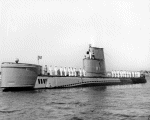 | 43k | Crew of the Barracuda (SSK-1) all dressed up in whites, date and place unknown. | USN photo. | |
 |
3.00k | 4 photo PDF of the Barracuda (SST-3) next to the quay wall, & T-1 (SST-1) away from the quay wall, alongside the Observation Island AG-154) at Norfolk Naval Shipyard, circa late 1950's. | Photos courtesy of NARA, National Archives Identifier: 6929052,Local Identifier: 19-NN-AG-154 Observation Island, From: Series: Photographs of U.S. and Foreign Naval Vessels, 1883 - 1972,Record Group 19: Records of the Bureau of Ships, 1940 - 1966, courtesy of Stephen Gower. Photo i.d. courtesy of Jim Christley, Ric Hedman, David Johnston (USN, retired) Robert Morgan & Ron Reeves (of blessed memory). | |
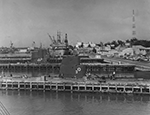 | 323k | Barracuda (SST-3) with the Tirante (SS-420) across the pier while down South. | Photo from the Author's collection (lost the real contributor). | |
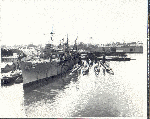 |
249k | Change of command at Subron 12 Key West Fla. in the 1960's aboard the Bushnell (AS-15). Barracuda (SST-3) upper right. Other boats there are Sea Cat (SS-399), Picuda (SS-382), Atule (SS-403), Sea Fox (SS-402), Threadfin (SS-410) & Chopper (SS-342). | Photo courtesy of John Hummel, USN (Retired). | |
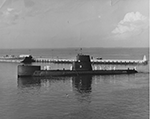 |
1.30k | Photo circa 1962 of the Barracuda (SST-3) returning to Key West Fla. My father, Ret. Capt. Daniel L. Bailey USNA Class of 47, was the Skipper at this time, 1/29/60-3/15/62. | Photo courtesy of Daniel L. Bailey Jr. | |
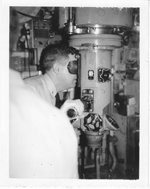 0855015 | 1.88k | LCDR Bailey on Barracuda's (SST-3) periscope, early 1960's. | Photo courtesy of Daniel L. Bailey Jr. | |
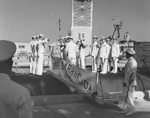 0855041 | 1.88k | Rear Admiral Lawrence Randall Daspit is saluted as he is piped aboard the Barracuda (SST-3), 1961. | Photos courtesy of Daniel L. Bailey Jr. | |
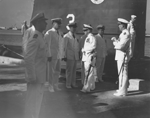 0855042 | 1.23k | Rear Admiral Lawrence Randall Daspit meets the Chief of the Boat, 1961. | Photos courtesy of Daniel L. Bailey Jr. | |
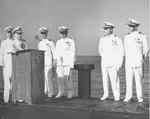 0855040 | 1.13k | Rear Admiral Lawrence Randall Daspit (Dan) of COMSUBLANT, COMNAVSUBFOR speaks before assembled officers. LCDR Bailey of the Barracuda (SST-3) is behind him. Dan Daspit was Tinosa's (SS-283) first CO. His account of the attack on Tonan Maru No. 3 is a jaw dropper. Although it is much juicer in Clay Blair's Silent Victory (pgs 435-439). Personally, my blood boils and consequently not even seeing those s.o.b.'s who contributed to the prolongation of the war, and the destruction of people's careers should be drawn, quartered, etc., is good enough, hopefully they will find a nice hot place in the earth. FYI None of this is in DANFS Despite the link above, I have included this on the assumption that things can change. After refitting at Midway, she got underway on 7 July to patrol the sea routes between Borneo and Truk. On 24 July 1943, Tinosa encountered the cargo ship Tonan Maru No. 3, the largest tanker of the Japanese fleet, 19,262 tons, sailing from Palau to Truk. Codebreaker warning [further explanation needed] had put Tinosa in a perfect position to shoot the tanker with a spread of four torpedoes. None exploded. The boat's commanding officer, Lieutenant Commander L. R. (Dan) Daspit recorded in his log, "Target had been carefully tracked and with spread used [torpedoes] could not have run properly and missed." The relevance of particular information in (or previously in) this article or section is disputed. The information may have been removed or included by an editor as a result. Please see discussion on the talk page considering whether its inclusion is warranted. (August 2019) Tinosa made herself a second chance by chasing throughout the following day. Daspit also checked the torpedoes he had left and insured that the magnetic influence exploders had been disabled (see below for why). Even so, the first two torpedoes of the second attack had to be shot at an awkward angle and range. They hit and exploded disabling Tonan Maru's engines. With the target dead in the water Tinosa was in an ideal firing position, moving in to fire on the tanker at the submarine equivalent of point blank range. The torpedo appeared to hit its target but did not explode. Daspit and crew continued to fire torpedoes one at a time at the tanker. All of them hit, but none exploded. Daspit's log gives time of firing of each and states over and over again "fired [nth] torpedo. Hit. No apparent effect." Daspit recorded about the sixth one since Tonan Maru had become a "sitting duck", "... Hit. No apparent effect. This torpedo hit well aft on the port side, made splash at the side of the ship and was then observed to have taken a right turn and to jump clear of the water about 100 feet (30 m) from the stern of the tanker. I find it hard to convince myself that I saw this." He took his sub to the other side of the target and fired the eighth and ninth torpedoes even as he saw a destroyer approaching from the east. As Tinosa went deep they heard the last torpedo hit and stop running. Daspit recorded in his log, "No explosion. Had already decided to retain one torpedo for examination by base." After shooting nine torpedoes at a sitting duck over almost an hour and a half 1009 to 1131, and taking time out to examine the fish in the torpedo room between shots, Lieutenant Commander Daspit took Tinosa back to Pearl Harbor with the single remaining weapon. Daspit stormed into SUBPAC's office. He had shot 15 torpedoes at Tonan Maru over two days and only 2 of them had worked. The others shot under ideal conditions failed to explode. Rear Admiral Lockwood, COMSUBPAC wrote: "I expected a torrent of cusswords, damning me, the Bureau of Ordnance, the Newport Torpedo Station and the Base Torpedo Shop, and I couldn’t have blamed him – 19,000 ton tankers don’t grow on trees. I think Dan was so furious as to be practically speechless. His tale was almost unbelievable, but the evidence was undeniable." [7] When, upon inspection, nothing obvious was found wrong with that last torpedo, Commander Swede Momsen suggested conducting tests on actual warshots by firing them against the cliffs of Kahoolawe, a small island south of Maui from the submarine Muskallunge (SS-262). The first two exploded. The third one did not. Within a few days the cause was traced to a firing pin that was mounted athwart-ships such that when the torpedo hit a target dead-on (ninety degree track angle) the deceleration forces slowed the pin's motion in its bearings and its spring could not move it fast enough to set off the explosive train. A glancing blow, however, would result in the proper behavior (which is why Daspit's first two torpedoes, fired at less optimum track angle, did explode). Two solutions were worked on. One involved recycling a very light metal alloy that had been melted down from the engine of a Japanese airplane that had crashed on Oahu during the bombing of Pearl Harbor. Both solutions were installed into torpedoes and the submarine force had a mostly reliable weapon 21 months after the war started. This was the third strike for the Mark 14 torpedo. It started with the Sargo (SS-188) missing 13 of 13 easy shots in December 1941. Finally in June 1942, Admiral Lockwood, the Commander of Submarines South West Pacific (COMSUBSOWESPAC), arranged to have torpedoes – with special non-exploding warheads (but unlike the exercise heads of that time and later they were filled to make them just as heavy as the actually explosive-filled warheads) – shot at fishnets. They were set to run at 10 feet (3 m). 850 yards (780 m) away they went through the nets at 25 feet (8 m) depth. The Bureau of Ordnance (BUORD) wouldn't accept this until they were forced to face the facts and conduct their own experiment. They confirmed Lockwood's experiments on 1 August. But that was not the end. In April 1943 BUORD admitted that the magnetic influence exploder was susceptible to premature explosions. Even then it wasn't until 24 July when Admiral Nimitz ordered that the influence exploders be disabled on all Pacific Fleet submarines. This did not apply, however, to COMSUBSOWESPAC. Admiral Christie then in command had been the officer in charge of testing the super secret influence exploder in the 1930s and he just could not give up on the concept and he ordered that his boats continue to use the defective magnetic exploder. This set the stage for Dan Daspit, Tinosa and the Tonan Maru to show that the contact exploder was defective as well, as described above.[8] |
Photo courtesy of Daniel L. Bailey Jr. | |
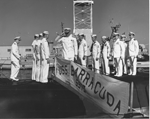 0855043 | 1.23k | Rear Admiral Mustin leaves Barracuda (SST-3) on a SUBRON 12 boat,1961. | Photo courtesy of Daniel L. Bailey Jr. | |
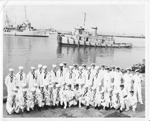 0855045 | 6.13k | Barracuda's (SST-3) crew,1961. | Photo courtesy of Daniel L. Bailey Jr. | |
 0855046 | 1.13k | Barracuda's (SST-3) Pennant presented to Lt. Cmdr. Daniel L. Bailey. | Photo courtesy of Daniel L. Bailey Jr. | |
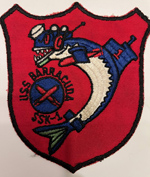 0855098 | 1.26k | Barracuda (SSK-1) Patch. | Photo courtesy of Daniel L. Bailey Jr. | |
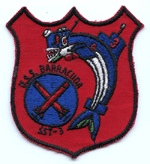 0855090 | 196k | Barracuda (SST-3) Patch. | Photo courtesy of Daniel L. Bailey Jr. | |
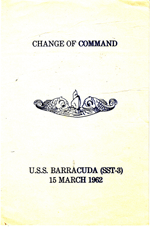 0855037 | 3.88k | 3 photo PDF Change of Command aboard Barracuda (SST-3), 15 March 1962. | Photo courtesy of Daniel L. Bailey Jr. | |
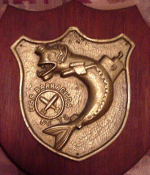 | 59k | Barracuda (SST-3), ships plaque. | Courtesy of George M. Arnold. | |
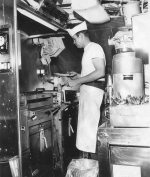 | 429k | Dan Moynihan, Barracuda's (SST-3) chef, preparing food in in the boat's galley, August 1970. | Courtesy of Dan Moynihan. | |
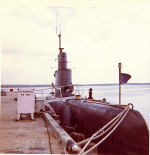 | 160k | Barracuda (SST-3) tied up, August 1970. | Courtesy of Dan Moynihan. | |
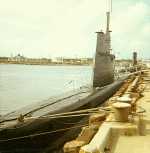 | 156k | Barracuda (SST-3) tied up with a unidentified friend behind her, August 1970. | Courtesy of Dan Moynihan. | |
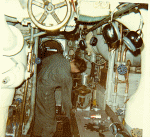 | 212k | Engineroom of the Barracuda (SST-3), August 1970. | Courtesy of Dan Moynihan. | |
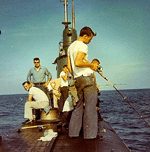 | 170k | Barracuda (SST-3) finally gets to shoot some fish: Once a quarter we would go out past 2 Charley, make a dive, then come up for some fishing off the South Carolina coast, August 1970. | Courtesy of Dan Moynihan. | |
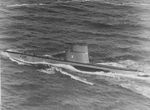 | 411k | Text on back of photo reads: April 1972; Charleston, South Carolina - The target & training submarine Barracuda (SST-3) conducts ship handling and training in the Cooper River. Note that her sonar bow has been removed. | Partial text i.d. courtesy of John Hummel, USN (Retired). US National Archives photo # 80-G-428gx, from NARA, College Park, Maryland, courtesy of Sean Hert. | |
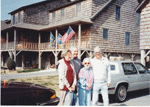 0855039 | 1.45k | May 1992 from left to right: Mom, Dad, Barbra & and Lou Larcombe at Sandbridge, VA. Lou Larcombe was Jimmy Carter’s roommate at the Academy. My parents and the Larcombe’s were very close friends. | Photo courtesy of Daniel L. Bailey Jr. | |
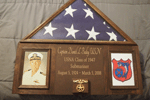 0855038 | 2.27k | LCDR Bailey: A Submariner, (Silent Service 1949-1975) Born 5 August 1924 – Death 5 March 2008. May his memory be for a blessing. |
Photo courtesy of Daniel L. Bailey Jr. | |
| Scrapping |
||||
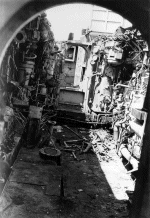 | 299k | The following pictures by Christopher Breeze show the Barracuda (SST-3) entering the scrapping process between 8 April 1974 through 8 July 1974 near Charleston, South Carolina, off East Bay Street. The bow plane is on right side. The boat is facing bow to river. The first two pictures might be in the after battery/mess hall, possibly looking aft into the engine room. | All scrapping photos courtesy of Christopher Breeze / Georgetown Steel Corporation & submitted courtesy of Ric Hedman. Photo ID courtesy of John Hummel, USN (Retired). |
|
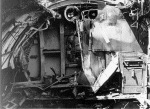 | 250k | After battery/mess hall. There is a small stove on the right side that possibly is the remains of the chow hall. | All scrapping photos courtesy of Christopher Breeze / Georgetown Steel Corporation & submitted courtesy of Ric Hedman. Photo ID courtesy of John Hummel, USN (Retired). |
|
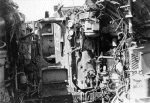 | 288k | The remains of the engine room. | All scrapping photos courtesy of Christopher Breeze / Georgetown Steel Corporation & submitted courtesy of Ric Hedman. Photo ID courtesy of John Hummel, USN (Retired). |
|
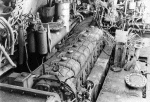 | 287k | The remains of the engine room. | All scrapping photos courtesy of Christopher Breeze / Georgetown Steel Corporation & submitted courtesy of Ric Hedman. Photo ID courtesy of John Hummel, USN (Retired). |
|
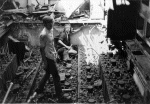 | 254k | The remains of the battery well. | All scrapping photos courtesy of Christopher Breeze / Georgetown Steel Corporation & submitted courtesy of Ric Hedman. Photo ID courtesy of John Hummel, USN (Retired). |
|
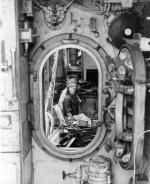 | 293k | The remains of the after battery above well (berthing). | All scrapping photos courtesy of Christopher Breeze / Georgetown Steel Corporation & submitted courtesy of Ric Hedman. Photo ID courtesy of John Hummel, USN (Retired). |
|
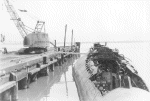 | 183k | The remains of the maneuvering room. | All scrapping photos courtesy of Christopher Breeze / Georgetown Steel Corporation & submitted courtesy of Ric Hedman. Photo ID courtesy of John Hummel, USN (Retired). |
|
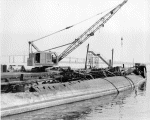 | 242k | One bow plane starboard side | All scrapping photos courtesy of Christopher Breeze / Georgetown Steel Corporation & submitted courtesy of Ric Hedman. Photo ID courtesy of John Hummel, USN (Retired). |
|
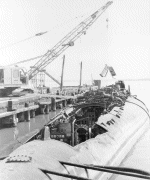 | 189k | Topside above maneuvering room. | All scrapping photos courtesy of Christopher Breeze / Georgetown Steel Corporation & submitted courtesy of Ric Hedman. Photo ID courtesy of John Hummel, USN (Retired). | |
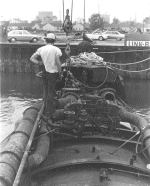 | 217k | Barracuda (SST-3) bow section being cut up. | All scrapping photos courtesy of Christopher Breeze / Georgetown Steel Corporation & submitted courtesy of Ric Hedman. Photo ID courtesy of John Hummel, USN (Retired). |
|
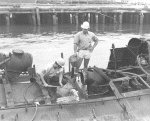 | 249k | Barracuda (SST-3) bow section being cut up. | All scrapping photos courtesy of Christopher Breeze / Georgetown Steel Corporation & submitted courtesy of Ric Hedman. Photo ID courtesy of John Hummel, USN (Retired). |
|
| Back To The Main Photo Index | Back To the Submarine Index |
| Problems and site related matters, E-mail Webmaster |
| This page is created by Gary Priolo, and maintained by Michael Mohl All Pages All Pages © 1996 - 2025 NavSource History. All rights reserved. |